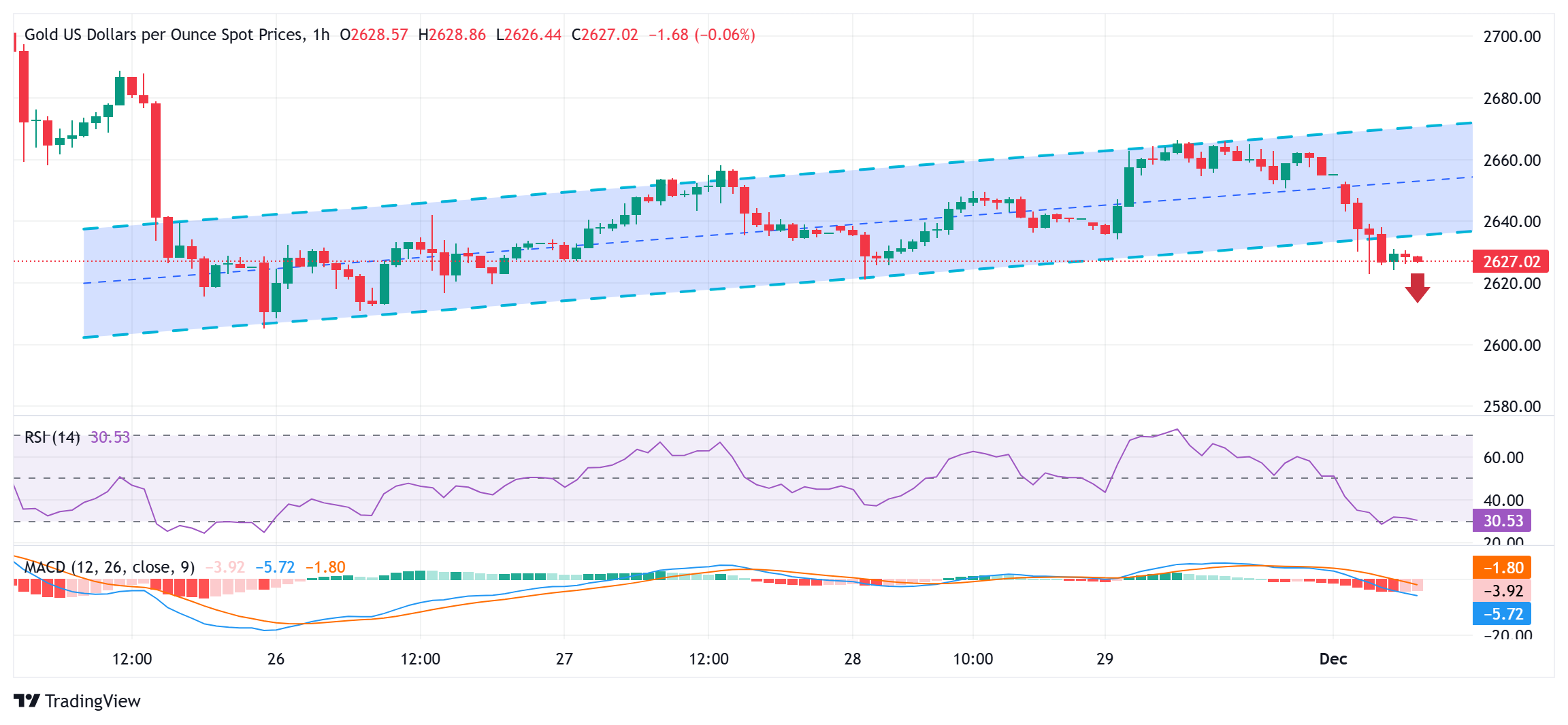- The price of Gold faces strong supply on Monday and breaks a four-day winning streak.
- The rebound in US bond yields helps revive demand for the USD and weighs on the commodity.
- Trade war concerns and geopolitical risks do little to support XAU/USD.
Gold price attracts strong selling at the start of a new week/month and falls to the $2,623-$2,622 zone during the Asian session, breaking a four-day winning streak amid a good rebound in Dollar demand American (USD). Expectations that US President-elect Donald Trump’s tariff plans could reignite inflationary pressures and limit the room for the Federal Reserve (Fed) to cut interest rates trigger a further rise in yields. US Treasuries. This, in turn, helps the USD stage a solid rebound from a near three-week low hit on Friday and turns out to be a key factor diverting flows from the non-yielding yellow metal.
Markets, however, continue to price it more likely that the US central bank will reduce borrowing costs later this month. This, along with lingering geopolitical risks stemming from the protracted war between Russia and Ukraine and conflicts in the Middle East, helps limit safe-haven gold price losses. Traders also appear reluctant, opting to wait for this week’s important US macroeconomic releases, including the closely watched Non-Farm Payrolls (NFP) report, for clues on the rate cut path. the Fed. This, in turn, will play a key role in influencing the USD price dynamics and determining the next leg of a directional move for the XAU/USD.
Gold Price Pressured by Rising US Bond Yields and Strong Pickup in USD Demand
- The US Dollar staged a good recovery from its lowest level since November 12 hit last Friday amid a new rise in US Treasury bond yields and weighs on the price of Gold at the start of a new week/month.
- Investors appear convinced that US President-elect Donald Trump’s tariff plans could trigger the second wave of trade wars and push consumer prices higher, forcing the Federal Reserve to pause rate cuts.
- In a critical post over the weekend, Trump threatened a 100% tariff on the BRICS nations – Brazil, Russia, India, China and South Africa – if they replace the USD with another currency for international transactions.
- Ukrainian President Volodymyr Zelenskyy has declared that he is willing to cede occupied Ukrainian territory to Russia, albeit with some conditions, to reach a ceasefire agreement and achieve peace.
- Russian and Syrian warplanes have carried out a series of airstrikes against Syrian rebels led by the jihadist group Hayat Tahrir al-Sham, who seized most of Aleppo in a surprise offensive on Saturday and entered the city of Hama.
- China’s official manufacturing Purchasing Managers’ Index (PMI) rose to 50.3 in November from 50.2, while the NBS non-manufacturing PMI fell to 50.0 during the reported month from 50.2 in October.
- China’s Caixin Manufacturing Purchasing Managers’ Index (PMI) jumped to 51.5 in November after recording 50.3 in October amid hopes that the government will introduce more stimulus to boost domestic demand.
- This week’s major US macroeconomic releases, starting with the ISM Manufacturing PMI later this Monday, will be watched for interest rate cuts, which in turn will boost the USD and XAU/ USD without performance.
The price of Gold seems vulnerable; one-week ascending channel break in play
From a technical perspective, an intraday drop below the lower boundary of a nearly week-old descending channel could be seen as a key trigger for bearish traders. Furthermore, the oscillators on the daily/4-hour charts have once again started to gain negative traction and suggest that the path of least resistance for the price of Gold is to the downside. Therefore, a further decline towards last week’s low, around the $2,605 region, seems a distinct possibility. Some follow-through selling below the $2,600 level would expose the 100-day SMA, currently situated near the $2,575 region.
On the other hand, the breakpoint of the uptrend channel support, around the $2,642-$2,643 zone, could now act as an immediate hurdle ahead of the static resistance at $2,652 and last week’s high, around the $2,665 region. Some follow-up buying should allow the price of Gold to reclaim the round $2,700 level and extend the positive move towards the $2,721-$2,722 supply zone. The latter should act as a crucial point, which if cleared decisively will suggest that the recent correction from the all-time high hit in October has come to an end and pave the way for a further appreciation move.
Gold FAQs
Gold has played a fundamental role in human history, as it has been widely used as a store of value and medium of exchange. Today, apart from its brilliance and use for jewelry, the precious metal is considered a safe-haven asset, meaning it is considered a good investment in turbulent times. Gold is also considered a hedge against inflation and currency depreciation, since it does not depend on any specific issuer or government.
Central banks are the largest holders of Gold. In their aim to support their currencies in turbulent times, central banks tend to diversify their reserves and purchase Gold to improve the perception of strength of the economy and currency. High Gold reserves can be a source of confidence for the solvency of a country. Central banks added 1,136 tons of gold worth about $70 billion to their reserves in 2022, according to data from the World Gold Council. This is the largest annual purchase since records exist. Central banks in emerging economies such as China, India and Türkiye are rapidly increasing their gold reserves.
Gold has an inverse correlation with the US Dollar and US Treasuries, which are the main reserve and safe haven assets. When the Dollar depreciates, the price of Gold tends to rise, allowing investors and central banks to diversify their assets in turbulent times. Gold is also inversely correlated with risk assets. A rally in the stock market tends to weaken the price of Gold, while sell-offs in riskier markets tend to favor the precious metal.
The price of Gold can move due to a wide range of factors. Geopolitical instability or fear of a deep recession can cause the price of Gold to rise rapidly due to its status as a safe haven asset. As a non-yielding asset, the price of Gold tends to rise when interest rates fall, while rising money prices tend to weigh down the yellow metal. Still, most of the moves depend on how the US Dollar (USD) performs, as the asset is traded in dollars (XAU/USD). A strong Dollar tends to keep the price of Gold in check, while a weaker Dollar is likely to push up Gold prices.
Source: Fx Street
I am Joshua Winder, a senior-level journalist and editor at World Stock Market. I specialize in covering news related to the stock market and economic trends. With more than 8 years of experience in this field, I have become an expert in financial reporting.







